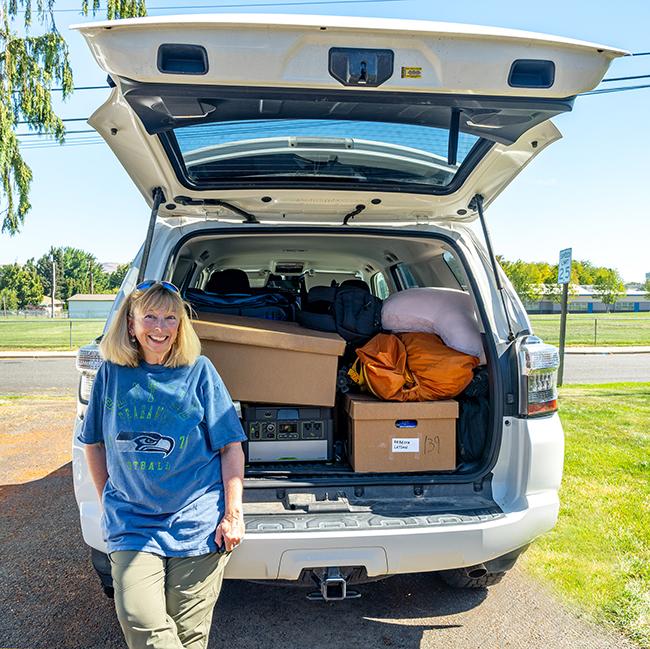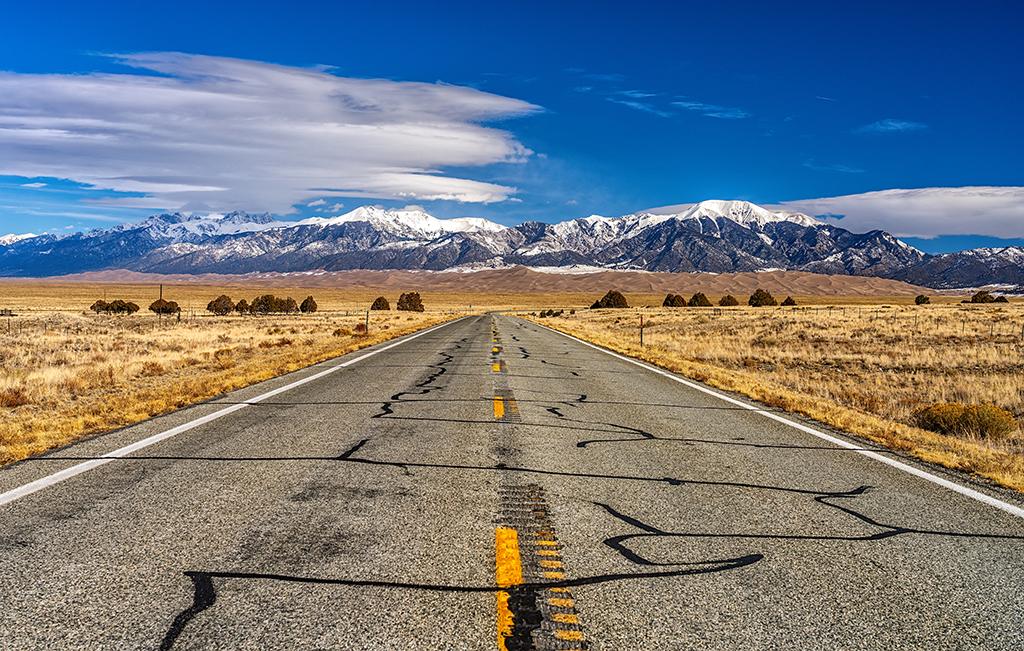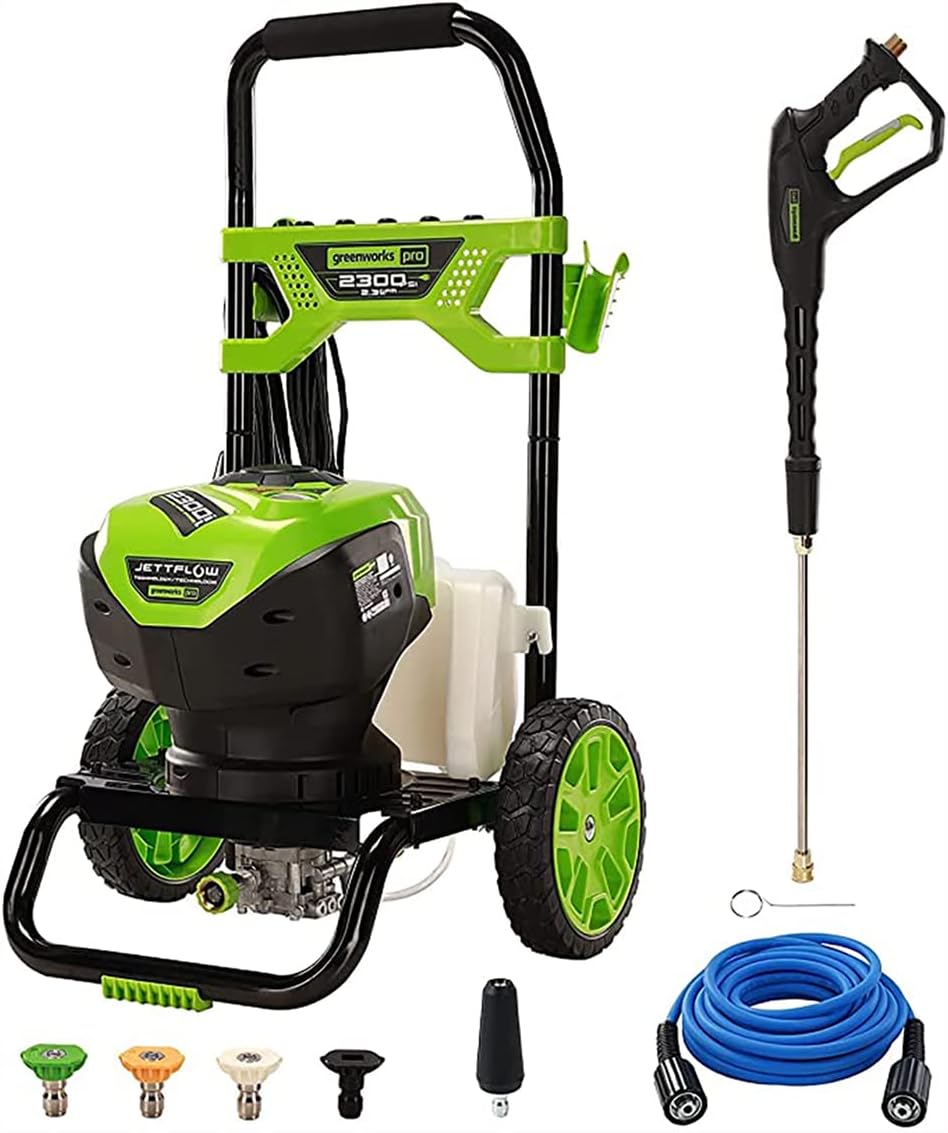The author bundled up and prepared for the winter weather, Great Sand Dunes National Park and Preserve / Rebecca Latson
During my February visit to Great Sand Dunes National Park and Preserve in Colorado, I remember sitting in the rental car after braving that incessant, freezing winter wind, eating a snack and thawing out with hot coffee from a thermos. Scanning the parking area, I noticed a young couple in their 20s parked beside me preparing to explore the area. Unlike me, covered head to toe in wool and insulated down and looking like a colorful version of the Michelin Man, this young man wore flared jeans and a jean jacket over his hoodie. His travel partner wore a hoodie over her multi-colored Lycra tights. Both wore sneakers. Each threw a blanket over themselves before advancing into that wall of freezing wind. I’m not certain 10 minutes even passed before I saw those same two scurrying back to clamber into their vehicle and drive away. Were they just acting on a spontaneous whim to quickly check out Great Sand Dunes, or had they intended a further exploration, realizing too late they had not thoroughly planned for winter’s bone-chilling elements?
Nowadays, a visit to a unit of the National Park System requires at least a minimal amount of planning and preparation. Some park units require timed entry reservations, lodging and campsite spots fill up faster, tours sell out quickly, and available rental vehicles might be hard to come by for a specific date. Whether you fly, drive, cruise, or ride the rails, planning ahead for your national park travel avoids these above-mentioned issues and ensures a smoother, more enjoyable stay.
I’ve been traveling on my own since the late 1990s, so I thought I’d write an article about how I plan for my own trips. As a matter of fact, I’ve spent the past month preparing for an upcoming 10-day April trip exploring and photographing Badlands and Wind Cave national parks and Jewel Cave National Monument in South Dakota, Devils Tower National Monument in Wyoming, and strandlines in Missoula, Montana, representing the remnant shoreline of the 2,000-feet-deep (610 meters) Glacial Lake Missoula along the Ice Age Floods National Geologic Trail.
Before reading further, be aware this article is quite subjective. I’ve a “kitchen sink mentality” (as in packing everything but the kitchen sink), but because I travel by myself, that mentality is more than a need-to-have vs. nice-to-have ideology. That said, I understand people prepare for trips in many ways. Some are packing minimalists (e.g. cowboy campers), some are moderate planners, and others are just like me. Whatever your style, there are planning and preparation basics everybody should consider for a national park trip.
For my national park trips:
- I look at my budget and figure out what I can afford to spend on travel, lodging, food, gasoline, and incidentals (souvenirs, tour reservations, emergency repairs).
- I decide where I might wish to travel and open that park’s website not only to learn what I can do while there, but to view alerts preempting what I’d like to do: road closures, construction alerts, facility closures, etc. “Know before you go” is crucial to trip planning. Always have a Plan B and Plan C.
- I open Google Maps for a mileage estimate from my home to my intended destination(s), should I choose to drive. I weigh that against the price of a plane ticket, car rental, and overall hassle of getting to the airport, checking in, etcetera. Driving is slower than flying, but I sure see more of the country while driving and feel more in control with my own well-maintained vehicle. I can also pack more for a road trip than when flying. If I choose to fly and rent a car, I make reservations for both of those as soon as practicable. I also purchase travel insurance in case I must cancel or, if I have the money/miles, I go ahead and purchase a fully-refundable ticket. If intending to drive my own vehicle, I schedule an appointment for maintenance (oil change, tire rotation, fluids inspection, etc.).
- I check weather conditions / forecasts for the time I’ll be traveling to aid in my clothing choices. Some national park websites have a dedicated weather page listing high and low averages for each month as well as what one can expect. For instance, early April is a mixed bag, so I’m mainly packing for cool and cold weather with a clothing item or two thrown in to cover a possible warm day. For those parks with no detailed weather page, I check the weather forecast for the town nearest that park unit. The closer it gets to my departure date, the more often I check the forecast.
- Once I decide on where to lay my head at night (brick-and-mortar room or a tent/camper setup at a campground or camping option like KOA or Good Sam Club), I make lodging reservations as soon as I can, even if it’s six months ahead of my departure date. I also make a point to read those cancellation policies. As a rule, unless I wait until the very last minute to cancel, I probably won’t be charged a cancellation fee (unless it’s Recreation.gov – don’t get me started on that).
- I reserve tour spots as soon as possible because I know they sell out quickly. If I must cancel, I try not to leave it until the last minute since somebody else out there might be able to take that tour for the day and time I cancel.
- I own a gasoline-powered vehicle. If I fly instead of drive and then rent a car, I want a gasoline-powered rental car. No, I’m not being political. The point here is that I don’t own an EV and don’t know much about them. A rental agency once tried to assign an EV to me and I ended up switching. I hadn’t done any homework regarding charging stations near my location and I totally wasn’t expecting to be handed the keys to an EV rental. Some national park units I visit are practically in the middle of nowhere, surrounded by small, rural communities. I understand the increasing popularity of EVs, but at this point in time, there are still more gas stations than charging stations. Other perceived inconveniences on my part regarding EV rental include how long the wait time might be while charging an EV (if there are even any charging stations near my destination) and how quickly the battery might run down in extreme cold. What say you, EV owners? Anything to dispel these misconceptions of mine?
- I always leave a travel itinerary with my sister. If flying, the itinerary includes airline and flight numbers as well as departure and arrival times. I include where I’m staying as well as the lodging phone number (my sister already has my cell number), and which park I’ll be visiting on certain days. Some of you want to be totally unplugged, and I get that. As a solo traveler, however, I just better having someone else know where I am on a given day.
- Many park units have gone or are going “cashless,” meaning cash is no longer accepted at park entrances and campgrounds. Instead, payment must be made via credit or debit card. It’s a hassle however you wish to pay, and you might be waiting in line awhile to make your payment at a busy park. Instead, get an annual pass, or if you are aged 62+, get a Senior Lifetime Pass. I did that and always carry that pass with me. It’s a quick action to show your pass and driver’s license, and some parks now have pass lines for quicker processing.

All set for my 2023 Canada road trip – yes, I overpacked and learned my lesson / Rebecca Latson
That’s the initial prep work for my trip. Now comes the list making. Below is a list template (sans clothing choices and toiletries) I use for most of my trips, with additions here and there for specific destinations. Believe it or not, except for a few items on this list, I am able to pack most of these into a couple of suitcases when flying (yes, I check in two suitcases and bring my camera pack and laptop bag as carry-ons). You’ll see more than just the basics on this list. It’s that kitchen sink mentality, plus the fact I have room to carry this stuff in my vehicle when driving. I’d rather have it and not need it, than need it and not have it.
- Clothing sprayed with tick/mosquito repellant – according to my Google searches, tick season begins around April in South Dakota.
- Bear spray – I highly doubt I’ll see any bears where I’m going, but I carry this in my vehicle anyway, since I travel to Mount Rainier National Park quite often. If you fly, know that airlines prohibit bear spray, so you might want to check into purchasing/renting a canister upon arrival at your destination.
- Tire valve caps and pressure gauge – I can’t tell you how often I’ve gotten a rental with no tire caps at all. Maybe that’s not a big deal, but I like the little bit of added protection a valve cap provides. Also, on occasion, I’ve gotten a low tire pressure alert requiring me to air up, and a pressure gauge is a handy item and easy to pack in my luggage.
- Small ice scraper – a large scraper resides permanently in my own vehicle, and it’s easy to pack a small scraper if you fly. Most rental agencies do not equip their cars with scrapers and it’s annoying to sit and wait for the windshield to defrost when I want to arrive at a sunrise view before sunrise.
- iPhone and charger – I carry one specifically for the vehicle and another for the room. That way, I never accidentally leave the charger in my room when I really need it for the vehicle.
- Satellite device. For my solo travel, this is a need-to-have item since there are still many places where cell service does not reach should an emergency occur.
- Wrist watch – Sure, my iPhone will tell me what time it is, but my Apple watch sort of looks out after me. During my camping adventure at Canada’s Jasper National Park, I tripped over a tent stake line and fell … hard. My Apple watch asked me if I was ok and if I didn’t respond within a certain amount of time, it would call for rescue. I wear an ID tag on the wristband with my name, emergency phone numbers, and a special code for EMTs and hospital personnel to access my medical information. In case I am unable to charge that watch, I also pack a regular automatic watch as backup onto which I can switch that ID tag.
- iPad – ok, this is a nice-to-have item. When not editing photos (or out photographing the night sky), I read from the Kindle app or play a downloaded movie at night.
- Sleeping bag or blanket – I pack that whether I camp or not. I’ve read countless articles of snowbound cars with very cold, occupants ill-prepared by not having food, water, or blankets.
- Water – I carry several gallon jugs of water for both drinking and reconstituting my freeze-dried meals. I also carry reusable water bottles for that drinking water when hiking.
- Freeze-dried meals (Mountain House is my favorite brand) – It’s boring to eat out while traveling solo, and personally I find it a waste of time when I could be eating in my room while editing photos, writing an article, or listening to/watching a movie on my iPad. Need-to-have for camping, nice-to-have for lodging. I also pack a bowl, coffee mug, and eating utensils in addition to spices for those meals.
- Hot pot – to boil water for my freeze-dried meals
- Coffee maker, coffee, and cream – not at all necessary but certainly nice to have, since I tend to drink coffee while working on photos and articles into the night (yeah, I don’t get much sleep on a photo trip – I can sleep when I get home).
- Surge protector to plug into the hotel/motel/lodge room for my laptop and to charge those camera, phone, and iPad batteries
- Snacks – not only important to carry while hiking, but heck, what’s a trip without fun snacks? They might also be life savers if you are stuck in your vehicle somewhere.
- Prescription meds
- Tool for cutting seatbelt fabric and cracking/breaking windows in event of an accident (if still conscious, that is)
- Air-activated hand warmers
- Knife
- Flashlights and batteries
- Candle/matches (if worst comes to worst, that candlelight might generate a little warmth)
- Shovel – I own a small, foldable shovel purchased at Costco in case I need to dig under my vehicle’s tires or create a little potty hole for myself.
- Mirror
- Jumper cables
- Duct tape
- Shop towels
- Tent, rainfly, ground cloth if camping
- Cookstove and utensils – if camping, although I know many use a small stove when driving, too.
- First aid items, including a needle to dig out pesky splinters – I store a plastic bin of first aid items in addition to extra toilet paper, paper towels, and garbage bags in my own vehicle. You can pack a small med kit in your luggage.
- Dash cam – this may sound like a nice-to-have item rather than a need-to-have item, but I feel better knowing I can chronicle any accidents or road events encountered while driving my vehicle. I use a front and rear dash cam setup. You’d be amazed at how careful the drivers behind tend to become once they spy that little camera attached to the rear windshield.
- Lithium storage battery – depending upon the size of the battery, you might be lugging around 40 pounds, but it sure is a handy device even when camping, not to mention great for emergency stops or power outages.
- Portable air compressor and/or jump start system for when you are out in the middle of nowhere.
Planning what to take with you on a national park trip (or any trip, really) makes sense. What I’ve written here is how I prepare for my trips. The list looks long, and you may roll your eyes as you read the list items, but I tell you it works for me and allows me an enjoyable time in the park(s). If you’ve read my travel/packing article I wrote for the Traveler back in 2017, you’ll see some things have changed while other things remain the same. I’m older, slower (ok, I was always slow, so that’s not really changed), and more cautious than when I was in my forties and still felt immortal. I’m far more safety conscious and understand more of my limits.
How do you plan for your national park adventures? How soon do you start preparing? What have I not listed in this article that is a must-have for your park trips?

The road into Great Sand Dunes National Park and Preserve / Rebecca Latson





